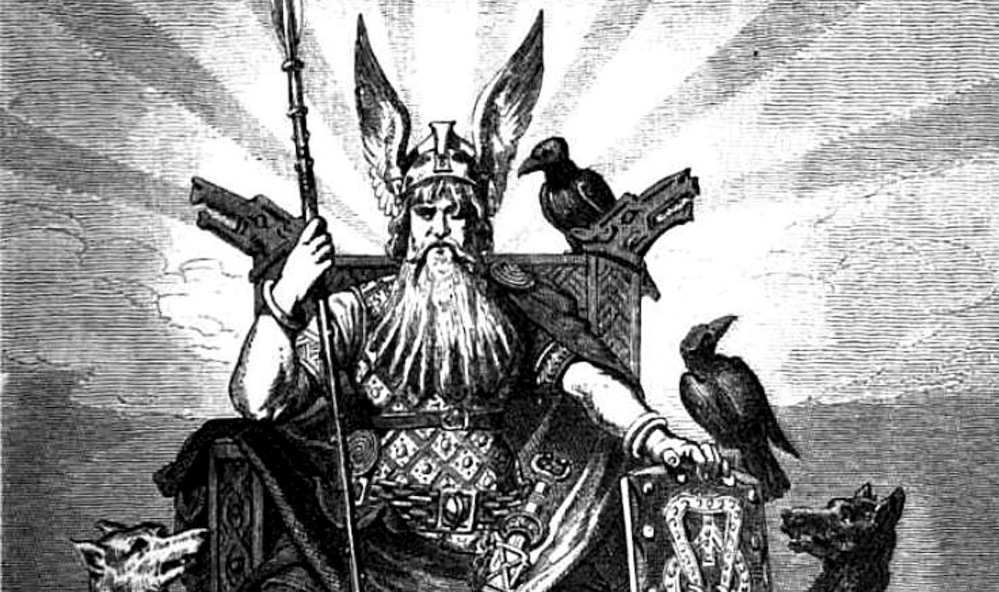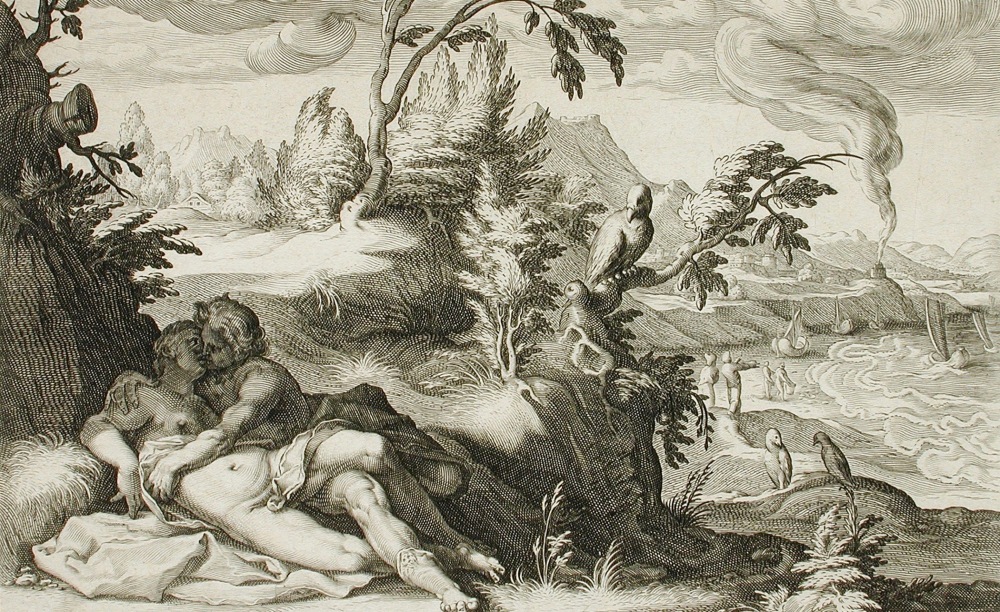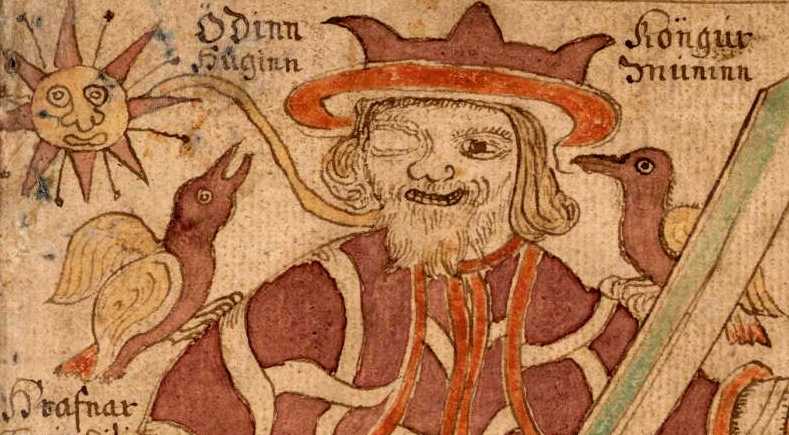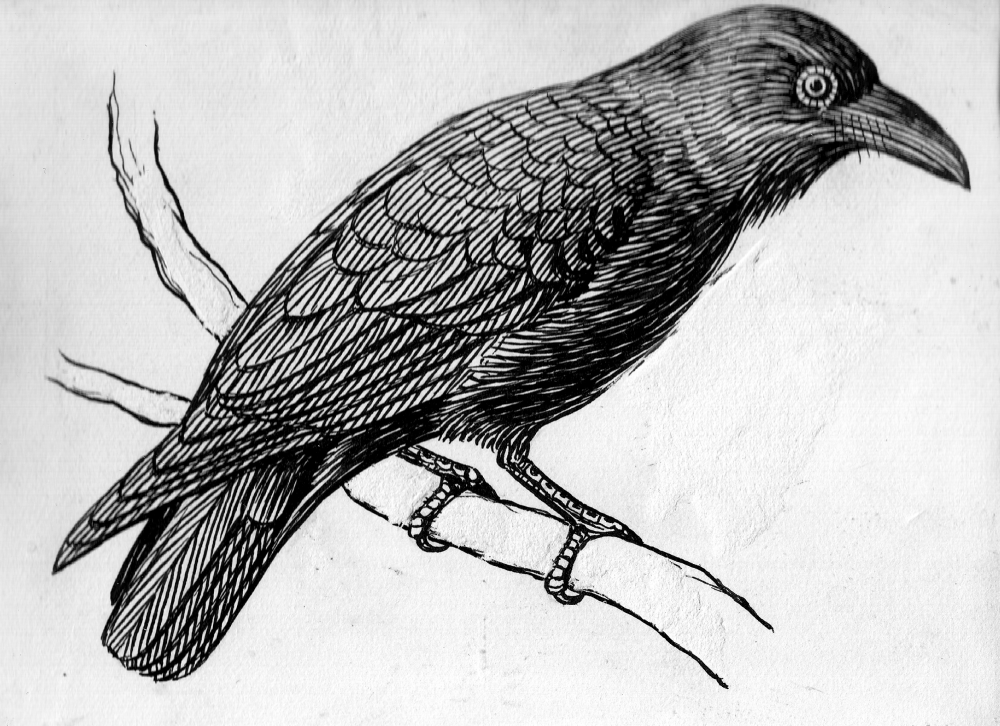The Raven is a favorite of Myth enthusiasts, whether racialists or otherwise, particularly because of its association to Odin. There Odin is said to have two messenger ravens, Huginn “thought” and Muninn “memory” or “mind.”
This association though becomes merely another reason to understand Odin as the Romana Interpretatio reveals him, a trickster God and guide to the “afterworld,” akin to the Semitic Mercury. Indeed, there are obvious reasons to dislike the symbol of the Raven instinctively, however, our feminine, childish, “inner Goth” might protest. The Raven is a black carrion bird associated with death. But there are also far more specific reasons.
Indeed, in my estimation, particularly as we review numerous other symbols appearing in Norse Myth, the raven referenced here is precisely the one that is associated with Apollo in the Greco-Roman myth. The Norse Myth is referencing the Greco-Roman or, more, a common symbol language. Here, to be clear, this association is a slander against Apollo and the Aryan Hyperborean type he represents. To this day, we will find this symbol deployed in JEM, carrying precisely the same meaning.

There two versions of the Myth of the raven in Greek mythology, one with an explicit cuckoldry theme, and the second with an esoteric cuckoldry theme. Together they allow us to corroborate the meaning of key esoteric symbols. In the first tale, the crow,[1] in his origin, is understood to have been originally white, something akin to a dove, which as this book will discuss, is strongly associated with racial purity. Indeed, ultimately, in the Greco-Roman, it is associated with Venus Urania, Venus in a pure, chaste form.
As does Odin, Apollo uses the bird as a messenger and spy. When the bird reports to him that his lover Coronis is having an affair with the mortal Ischys,[2] the Sun God’s anger is so great that the bird is turned black by his glare. Likely this is related to a motif in JEM, where Jews identify Jewish characters through the symbolic color of black, particularly through character name meanings. Here we take “black” to mean, dark, swarthy or Semitic as opposed to the modern sense of that word. One likely source of this appears in the Song of Solomon where the male lover, understood as the Jewish God by Jews and Christians alike, refers to himself as “black.”[3] There his hair is described as black as a “raven.”[4]
The raven, as a symbol appearing in this tale, seems to suggest something that has been “blackened” or corrupted through Semitic intermixture. This “blackening” reminds us as well of the corruption or descent of the Triple Goddess. Here it is important to note that the unfaithful lover’s name Coronis actually means “raven.” Hence, in contrast to the symbol of the white dove, representing the pure unsullied Aryan Venus, the raven represents the Semitized blood.
There is a second version of the tale describing the raven’s origin that is profoundly illuminating. In it the God Apollo sends the crow to collect water from a stream. Here, as will appear in the esotericism, water becomes a feminine symbol, related to nymphs, naiads and Aryan women. While at the stream the crow spies a fig tree and rather than retrieve the water, he waits for the fig tree to ripen so that he can eat the fruit. The fig, as this book discusses, is a clear vaginal symbol, while the tree as a general symbol may be related to Aryans as this book reveals.

The crow, fearful that his tardiness will be punished, returns to Apollo with the water and also a snake, ostensibly as compensation for being late. The snake is a Semitic symbol, as this book reveals, related to Bacchus. Here it seems even possible, that the crow, a Semitic or Semitized figure, is presenting a kind of swap. Here the Semite is given access to Aryan stocks, while the Aryan, Apollo, is given access to Semitic stocks or pleasure, racial dissolution and degeneracy more generally. This conforms to the Semitic Bride Gathering thesis outlined in this study.
Apollo does not accept the terms. He punishes the crow by throwing him, the goblet containing the water and the serpent into the heavens where they will form the constellations Corvus, Crater and Hydra.
In Catholic symbolism the Raven is considered the symbol of the Jews of confession and penance. Though it is not viewed negatively per se. While sometimes representing the devil, it is understood as having assisted and fed at least three saints whom include St. Benedict, St. Anthony the Abbot and St. Paul the Hermit.
Likewise, contemporary examples of the “Raven motif” abound in JEM. Clementine Kruczynski appearing in the Eternal Sunshine of the Spotless Mind is another example. Her last name appears to be derived from the Polish word Kruczy, meaning corvine. In this film, Clementine is an Aryan consort to the Jewish figure Joel Barish.

Pam Byrnes, the Aryan love interest of the Jewish figure Greg Focker appearing in Meet the Parents is another example. Byrnes means “raven” and a poem her father recites in the film referencing Edgar Allen’s Raven, corroborates this. The film contains a clear Semitic Bride Gathering theme. The Aryan villain of the Scarecrow in the Batman comics, created by Jewish esotericist Bill Finger, is another example as this study will explicate. Here he is defending, if vainly, an Aryan crop from “ravens” or racial cuckoldry. Ravens appear as well, saliently, in The Game of Throne Series, ostensibly, merely riffing off the Norse myth. Yet there is great consciousness here.
Indeed, if George R.R. Martin, a person of quarter Jewish ancestry, has almost certainly, secretly identified as a Jew for a long period. Indeed, Interpretatio Romana establishes that he is practicing JEM in his films as only it may. Of course, even if Martin’s Saturnian castration fetishes were a mere “Jungian manifestation” and simple degenerate Art, surely we would be obliged to oppose them.
But here the reference in Norse Myth is the most profound. There the raven is associated with memory and thought. But what precisely is this memory and thought? As we will see in symbolism expressed from Sumer to now, in contemporary JEM and Christianity, the memory and thought is racial cuckoldry, is Racial Esoteric Demoralization. After all this is the great reoccurring theme that appears in JEM, which, through many myths, has become the “memory” of Aryans, even the accepted, “fond, proud memory.”

Indeed, in this regard the Jewish dominated porn industry lays the great “sacred,” “profound” leitmotif of “Yahweh” through all Jewish Art and “Mystery” Religion bare. It is “Revelation,” the final, least sublimated “Jewish Art.” Indeed, porn in even its most basic form is a celebration of cuckoldry. Here men are watching largely Aryan women having sex with men, very frequently in the employ of Jews if not Jews themselves, now often non-white. The Aryan man is made demoralized, impotent by the insertion of this Jewish taunt.
Certainly, the Raven is a “taunt-symbol” or “hate symbol” against Aryan men and the “purity” of Aryan women. This is particularly true in the way the symbol is deployed in Jewish Art. Hence, we have no choice but to regard it in the manner it was intended. Of course, when men taunt men in this regard, where life and continuance itself is on the line, they should know fully what to expect. That they are, like Bacchus, too effeminate to make these remarks openly, does not spare them the consequences of men, quite the contrary. Indeed, he who desires the rights of men must first be one. Hence he found practicing the womanly indirection of JEM through Art or Religion, Christianity, Judaism or otherwise, loses these rights. This we will make law. Art and Religion will become sacred again.

[1] As a symbol, the raven is used interchangeably with the crow, both members of the Corvus genus.
[2] Some versions of the tale indicate the figures Alcyoneus or Lycus as the lover.
[3] Song of Solomon 1:5 “I am black, yet lovely, O daughters of Jerusalem, like the tents of Kedar, like the curtains of Solomon. Do not stare because I am black, for the sun has gazed upon me.” Christians commonly assert this is a description of the woman and not the man (presumed to be Yahweh) in the poem. However no evidence suggests this. Though it is clear that the poem is a dialog between lovers, speakers are not identified from this passage to that. While scholars are able to reach consensus on later passages of the poem as to which speaker is speaking, 1:1–6 is commonly classed “introduction” while 1:17 -2:7 simply Dialogue between lovers. The speaker is addressing the daughters of Jerusalem. Perhaps this suggests a male perspective particularly in the context of a love poem where the male is understood a courter. Likewise 1:6 indicates the speaker a vintner, a male profession in the ancient world, arguably equating him the Semitic Bacchus as was Yahweh by ancient mythographers. Elsewhere in the poem the female, possessing breasts or “shad,” שַׁד, is praised as “fair” or Japheth such as in 4:1. There experts are in agreement, the man is addressing the “Japheth” women. All of this, of course, is weighed against a consistent self-perception appearing in Jewish Esoteric Moralization, where Jews commonly feel themselves to be the darker man vying for fairer stocks.
[4] Song of Solomon 5:11
There are Ravens in Lord of the Rings as well. Do you think Tolkien knew of Romana Interpretatio or just accidentally protrayed the spying Ravens as related to the Semetic Mountain/Fire/Vulcanic god of Sauron in LOTR.
LikeLiked by 1 person
I’m of course familiar with Tolkien but I haven’t made a close study of his work. There could be some instinct there. On the other hand, he was a Catholic, ostensibly, and they represent Jews in Catholic symbolism.
LikeLike
Very true. So it was probably just guided by instinct and story-telling in juxtaposition to CS Lewis the “symbolist.” Lol. And he countersignaled Fascism which is another sign of Tolkien’s inability to diagnose society and the dangers of English liberalism that are manifest today.
Some of the Ring symbolism is interesting. Tolkien story intended three of the rings to be worn by Elves, Seven by Dwarves (the number of Saturn), Nine by Men, and one, the One Ring, by Sauron himself in Mordor.
The story definitely resonates with our people in some respects, but might have some deleterious symbolism embedded due to his ignorance of Jewish influence.
LikeLiked by 1 person
I agree. It’s a mixed bag.
LikeLike
Do owls symbolise anything? i’m thinking of the bohemian grove
LikeLike
Yeah. Nocturnal. Effectively Semitic. Minerva or Athena represents the Aryan woman extracted from the Aryan man, Jupiter, by a Semitic competitor, Vulcan. Her bird is the owl.
LikeLike
Hmm. Another question, somewhat unrelated. Do you think the heavy metal meme of “Goth girls” aka black hair with blue eyes is a semitic subversion? maybe it just happened organically.
LikeLike
I am not closely familiar with the history of that genre of music. It definitely venerates Chthonic themes. Could have been entirely organic. But anyone could do a deep dive and figure out who the prime movers were. I am frequently amazed by what a little research uncovers.
LikeLike